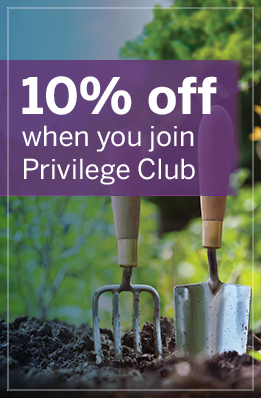- Small gardens with little room for permanent planting in the ground
- Patios close to the house needing colour and interest
- Paths and other hard surfaces needing brightening up
- Shady areas under trees where it is difficult or impossible to plant in the ground
- Walls and fences needing colour to brighten them up
- Front doors and entrances needing statement plants


Container plants
During summer, we spend a lot of time outdoors, entertaining and dining on our patios, so they need to be colourful and welcoming. Some gardens are so small that there’s only room for a patio or for a few plants growing in containers. So which ones are best?
What to look for
Patio gardens – pots, containers and hanging baskets
Just about every plant can be grown in a container! The most important thing to consider is the size of the container. It needs to match the size of the plant and, more importantly, be big enough to support the plant’s root growth – which, in turn, supports the top growth, stems and leaves, by absorbing water and nutrients.
Small trees, shrubs, climbers, herbaceous plants, bulbs and bedding plants are all suitable for container growing. As are fruit and vegetables, if you don’t have room for a kitchen garden elsewhere.
Trees, large shrubs and climbing plants need deep containers to support their root growth. Deep terracotta or metal pots are also heavier and less likely to blow over in windy weather.
Container growing is also perfect for plants that wouldn’t otherwise thrive growing in the ground. This includes lime-hating/acid-loving, ericaceous plants if your soil is alkaline, growing them in lime-free ericaceous compost. Also growing plants under trees or near to hedges where the roots of the tree or hedge rob the soil of all the water and nutrients, and other plants struggle to establish and thrive.
While a good multi-purpose or potting compost is suitable for annual and bedding plants, a loam-based John Innes compost is better for long-term plants. John Innes is also heavier, so better for tall plants in windy situations. Or you can mix the two together, using roughly equal parts of each.
Always bear in mind the aspect or conditions – shade or very sunny positions – and choose plants accordingly.
What’s good about patio gardens – pots, containers and hanging baskets?
It’s perfect for growing plants that can’t be grown in the ground – or in situations where there’s no soil to plant them in.
Tender plants and those that would suffer from damage from frost or cold temperatures if kept outside in winter can be moved to the protection of a heated greenhouse or cool conservatory, extending the range of plants you can grow. Those that are borderline hardy can be moved close to the protection of a south-facing wall.
As root growth is restricted, otherwise tall or large plants will have their height restricted, so you can grow and control plants that would otherwise be too big in the rest of the garden.
What’s bad about patio gardens – pots, containers and hanging baskets?
Being in containers, with restricted root growth, the plants are totally reliant on you for all their water and nutrient requirements. So, they need regular watering – the aim being to keep the compost evenly moist – and feeding to supply a regular supply of nutrients while they’re growing – from March/April to mid- to late autumn.
It’s more expensive, as you have to buy the containers and the compost.
Plants
While just about all plants will grow in containers, here are a few considerations to bear in mind.
Trees and shrubs
Even deciduous trees and shrubs provide structure and interest from their branches once their leaves fall in autumn.
As well as flowers, don’t forget about berries, fruit, autumn leaf colours and interesting stems or bark to extend the seasons of interest.
Fruit
Buy “patio” fruit trees or those growing on dwarfing or semi-dwarfing rootstocks.
Strawberries will even grow in a hanging basket.
Rhubarb is one of the few plants that doesn’t always thrive in containers.
Vegetables
Fruiting vegetables, such as tomatoes, aubergines, peppers and cucumbers, fruit particularly well in containers.
You can even grow mini lettuces, salad leaves, stump-rooted carrots and other low-growing or short-rooted vegetables in a window box or hanging basket.
Bedding plants
All bedding plants – summer- as well as spring-, autumn- and winter-flowering – are perfect for containers and bring lots of colour to areas where there is no soil to plant in the ground.
Herbaceous perennials
Many perennials die down in winter, resulting in bare containers.
Bulbs
All bulbs grow brilliantly in containers – either on their own or combined with other plants. Just remember that they will die back and become dormant at certain times of year, resulting in bare containers.


